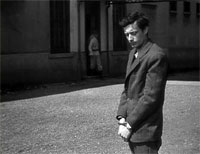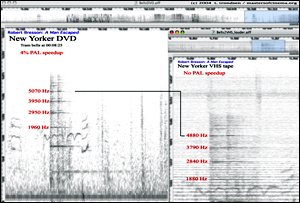
|
Trond S. Trondsen / mastersofcinema.orgPAL Speedup — Case Study: A Man Escaped (New Yorker DVD)
In this day and age, when art of numerous kinds is increasingly being disseminated by electronic means, it is of
critical importance to pay attention to the underlying technology and its inherent limitations. This
especially in view of the fact that the "digital representation" of a work of art — be it a painting,
a musical composition or a film — may very well be the only representation easily accessible to a given
listener or spectator, whether Fine Arts student or fanboy.
The idea for this article on the topic of PAL Speedup was born when I received the following message from my robert-bresson.com
co-admin Doug Cummings who had just received his New Yorker A Man Escaped DVD:
"I've just watched the first five minutes and I swear I can notice a slightly higher pitch/pace
to everything. Could 4% actually be noticeable or am I just hypersensitive now?"
Let us turn our attention to Robert Bresson's A Man Escaped [R1/NTSC DVD, New Yorker Video, May 2004], an unfortunate victim of PAL speedup. There exists no valid excuse for subjecting an NTSC DVD to PAL speedup. PAL speedup is out of line and entirely avoidable, as already pointed out in our review of the DVD. It is especially egregious when a classic of film history, continually under analysis by students and scholars, is subjected to such irresponsible treatment. This problem is not limited to New Yorker Video. The main focus of this brief report is on the change in pitch of the audio track of a film we dearly love. It is not our intention to condemn native PAL as a video format, but rather to question the use of PAL masters for NTSC DVD releases. The associated problem of "ghosting" will not be touched upon, as this has been adequately addressed elsewhere. We will compare audio samples taken from the recent (May 2004) New Yorker DVD to audio samples taken from the old New Yorker VHS tape. The DVD suffers from PAL speedup, as we have already established. The VHS tape does not suffer from PAL speedup, as it was not mastered from a PAL source. Just how noticeable is the speedup? We're about to find out. The following matrix contains three audio samples (in mp3 format) excerpted from A Man Escaped. The first column contains three samples taken from the VHS, the second column has the corresponding audio clips from the DVD (suffering from speedup), and the third column has the previous VHS and DVD audio samples stacked back-to-back to ease comparison. Concentrate on pitch, and ignore the slight differences in volume and audio quality; the sonic quality the VHS audio track, with its hiss, is of course inferior to that of the DVD.
The above comparison speaks for itself — the semitone shift in pitch is very noticeable indeed. Many Bressonians are intimately familiar with the film from seeing it repeatedly in the theatre, and will immediately spot the 4% speedup on the DVD (case in point: Doug, as referred to in the article's introduction). The rest of us will readily agree that the shift is quite significant once we're presented with the "stacked" clips in the right hand side column above.
The "tram bells" audio clips contain some very distinct frequency components and lend themselves especially well to a numerical analysis, thus providing us with hard facts rather than mere subjective impressions that may depend on how well-trained one's ear is (or is not). The following figure (click to enlarge) shows the sonogram (Fourier spectrum) of the tram "ding-ding!" of the DVD on the left and that of the VHS on the right. We have roughly measured and labelled four discrete frequency components (red labels). Comparing the labelled frequency components of the DVD spectrum to the corresponding components in the VHS spectrum on the right clearly shows an approximately 4% frequency shift.
NTSC has its own problems, to be sure, but thanks to its 30 fps frame rate, combined with the 3:2 pulldown scheme, it is capable of reproducing the correct film speed of almost exactly 24 frames per second. Thus, native NTSC transfers form an excellent baseline for film speed comparisons. (To be entirely precise, the exact NTSC film frame rate is a tiny bit lower than 24 fps: it is 59.94/60*24 = 23.976 fps, an imperceptible slowdown. Our hypothetical Sátántangó NTSC DVD release hence lasts 27 seconds longer than it did in the theatre. Which, resolution advantages aside, in our mind is much preferable to the 20 minutes shorter PAL version.)
Article_v.1.1 – May 29, 2004.
|






